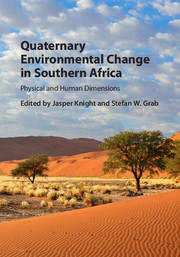Book contents
- Quaternary Environmental Change in Southern AfricaPhysical and Human Dimensions
- Quaternary Environmental Change in Southern Africa
- Copyright page
- Contents
- Contributors
- 1 The context of Quaternary environmental change in southern Africa
- 2 A brief geological history of southern Africa
- 3 A continental-scale perspective on landscape evolution in southern Africa during the Cenozoic
- 4 Hominin origins and evolution during the Neogene
- 5 Hominin evolution in Africa during the Quaternary
- 6 Quaternary environmental change on the southern African coastal plain
- 7 Dating the southern African landscape
- 8 Glacial and periglacial geomorphology
- 9 Colluvial deposits and slope instability
- 10 Desert dune environments
- 11 Changes in fluvial systems during the Quaternary
- 12 Wetlands in southern Africa
- 13 Sandy coasts
- 14 Environmental change during the Pleistocene and Holocene: Estuaries and lagoons of southern Africa
- 15 Soils and duricrusts
- 16 Karstic systems
- 17 Terrestrial ecosystem changes in the late Quaternary
- 18 Faunal evidence for mid- and late Quaternary environmental change in southern Africa
- 19 Pollen, charcoal and plant macrofossil evidence of Neogene and Quaternary environments in southern Africa
- 20 Minerogenic microfossil records of Quaternary environmental change in southern Africa
- 21 Development of the archaeological record in southern Africa during the Earlier Stone Age
- 22 Development of the archaeological record during the Middle Stone Age of South Africa
- 23 Later Stone Age hunter-gatherers and herders
- 24 Southernmost Africans, archaeology and the environment during the Holocene
- 25 Landscape–climate–human relations in the Quaternary of southern Africa
- Index
- References
4 - Hominin origins and evolution during the Neogene
Published online by Cambridge University Press: 05 June 2016
- Quaternary Environmental Change in Southern AfricaPhysical and Human Dimensions
- Quaternary Environmental Change in Southern Africa
- Copyright page
- Contents
- Contributors
- 1 The context of Quaternary environmental change in southern Africa
- 2 A brief geological history of southern Africa
- 3 A continental-scale perspective on landscape evolution in southern Africa during the Cenozoic
- 4 Hominin origins and evolution during the Neogene
- 5 Hominin evolution in Africa during the Quaternary
- 6 Quaternary environmental change on the southern African coastal plain
- 7 Dating the southern African landscape
- 8 Glacial and periglacial geomorphology
- 9 Colluvial deposits and slope instability
- 10 Desert dune environments
- 11 Changes in fluvial systems during the Quaternary
- 12 Wetlands in southern Africa
- 13 Sandy coasts
- 14 Environmental change during the Pleistocene and Holocene: Estuaries and lagoons of southern Africa
- 15 Soils and duricrusts
- 16 Karstic systems
- 17 Terrestrial ecosystem changes in the late Quaternary
- 18 Faunal evidence for mid- and late Quaternary environmental change in southern Africa
- 19 Pollen, charcoal and plant macrofossil evidence of Neogene and Quaternary environments in southern Africa
- 20 Minerogenic microfossil records of Quaternary environmental change in southern Africa
- 21 Development of the archaeological record in southern Africa during the Earlier Stone Age
- 22 Development of the archaeological record during the Middle Stone Age of South Africa
- 23 Later Stone Age hunter-gatherers and herders
- 24 Southernmost Africans, archaeology and the environment during the Holocene
- 25 Landscape–climate–human relations in the Quaternary of southern Africa
- Index
- References
Summary
The record of early hominin evolution derives mainly from central and eastern African fossils, with basal forms appearing in the late Miocene (~8.00–5.33 Ma). Recent research suggests that a key distinguishing hominin feature, bipedalism, may have first emerged primitively in wooded environments. Miocene hominins are divided into three genera, Sahelanthropus, Orrorin and Ardipithecus. These groups may represent anagenesis during the late Miocene and early Pliocene. With the appearance of Australopithecus in the early Pliocene, hominins arguably fully commit to bipedality. At present, data indicate that an archaic form of Australopithecus, A. afarensis, was the first eurytopic hominin and the first to expand into southern Africa. By the end of the Neogene, separate hominin species can be recognised in eastern and southern Africa. At present, the earliest South African Australopithecus fossils derive from Sterkfontein, Member 2 and Makapansgat, Member 3.
- Type
- Chapter
- Information
- Quaternary Environmental Change in Southern AfricaPhysical and Human Dimensions, pp. 47 - 66Publisher: Cambridge University PressPrint publication year: 2016
References
- 1
- Cited by



